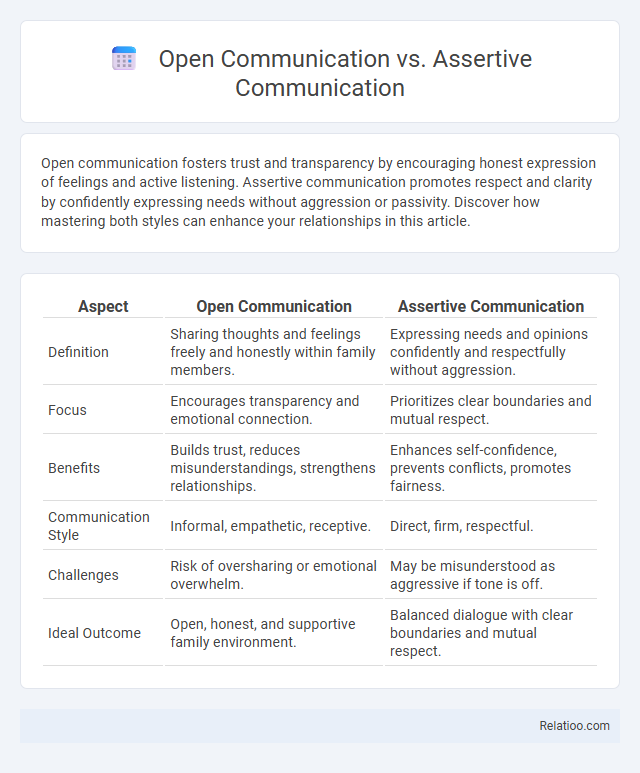Open communication fosters trust and transparency by encouraging honest expression of feelings and active listening. Assertive communication promotes respect and clarity by confidently expressing needs without aggression or passivity. Discover how mastering both styles can enhance your relationships in this article.
Table of Comparison
| Aspect | Open Communication | Assertive Communication |
|---|---|---|
| Definition | Sharing thoughts and feelings freely and honestly within family members. | Expressing needs and opinions confidently and respectfully without aggression. |
| Focus | Encourages transparency and emotional connection. | Prioritizes clear boundaries and mutual respect. |
| Benefits | Builds trust, reduces misunderstandings, strengthens relationships. | Enhances self-confidence, prevents conflicts, promotes fairness. |
| Communication Style | Informal, empathetic, receptive. | Direct, firm, respectful. |
| Challenges | Risk of oversharing or emotional overwhelm. | May be misunderstood as aggressive if tone is off. |
| Ideal Outcome | Open, honest, and supportive family environment. | Balanced dialogue with clear boundaries and mutual respect. |
Introduction to Communication Styles
Open communication emphasizes transparency and sharing information freely, creating an environment where ideas flow without barriers. Assertive communication balances honesty with respect, enabling you to express your needs and opinions confidently without infringing on others. Understanding these communication styles helps improve your interpersonal interactions and fosters more effective and respectful exchanges.
Defining Open Communication
Open communication involves freely sharing ideas, feelings, and information in a transparent and honest manner, fostering trust and collaboration among individuals or teams. Unlike assertive communication, which emphasizes expressing needs and boundaries confidently and respectfully, open communication prioritizes creating an inclusive environment where feedback flows both ways without fear of judgment. In contrast to passive communication styles, open communication ensures clarity and mutual understanding, enhancing organizational efficiency and interpersonal relationships.
What is Assertive Communication?
Assertive communication is a clear, direct way of expressing thoughts, feelings, and needs respectfully while maintaining others' rights. It balances honesty and openness without being aggressive or passive, promoting mutual understanding and effective conflict resolution. This communication style enhances relationships by encouraging transparency and confidence.
Key Differences Between Open and Assertive Communication
Open communication emphasizes transparency and sharing information freely among individuals or teams, fostering trust and collaboration without necessarily imposing opinions. Assertive communication centers on expressing one's thoughts, feelings, and needs confidently and respectfully, ensuring personal boundaries are maintained while engaging others. The key difference lies in open communication prioritizing mutual exchange and receptiveness, whereas assertive communication focuses on self-expression and standing firm on personal rights within interactions.
Benefits of Open Communication
Open communication fosters transparency, builds trust, and enhances collaboration by encouraging honest dialogue and active listening. It allows your team to address issues promptly, reducing misunderstandings and conflicts while promoting a positive workplace culture. Prioritizing open communication creates an environment where everyone feels valued and empowered to contribute ideas, boosting overall productivity and morale.
Advantages of Assertive Communication
Assertive communication enhances clarity by expressing thoughts and feelings directly while respecting others, reducing misunderstandings compared to general open communication. It promotes mutual respect, fosters confidence, and builds stronger interpersonal relationships by balancing honesty with empathy. This communication style supports conflict resolution and decision-making more effectively than passive or aggressive approaches.
Common Challenges in Open vs Assertive Communication
Common challenges in open communication include a lack of clarity and potential misunderstandings due to over-sharing or ambiguous messages. Assertive communication faces obstacles such as fear of confrontation and difficulty balancing honesty with respect, which can lead to either passive or aggressive interactions. Both styles require emotional intelligence and practice to maintain effectiveness, especially in professional or sensitive contexts.
Situational Appropriateness: When to Use Each Style
Open communication suits collaborative environments promoting transparency and trust, enabling free information exchange and idea sharing. Assertive communication is ideal for situations requiring clear boundaries, confident expression of needs, or conflict resolution without aggression or passivity. Closed communication fits contexts needing confidentiality, control, or hierarchical decision-making, limiting information flow to maintain order and security.
Tips for Improving Communication Skills
Improving communication skills involves understanding the differences between open communication, assertive communication, and passive communication. Open communication encourages transparency and active listening, fostering trust and clarity, while assertive communication empowers you to express your thoughts and needs confidently without aggression or passivity. Tips for enhancing your skills include practicing active listening, using "I" statements to convey feelings, and maintaining eye contact to create a respectful and effective dialogue.
Conclusion: Choosing the Right Communication Approach
Choosing the right communication approach depends on context, goals, and audience needs. Open communication fosters transparency and trust by sharing information freely, while assertive communication balances confidence with respect, promoting clear and direct expression of thoughts. Understanding when to employ open versus assertive communication enhances interpersonal effectiveness and drives positive outcomes.

Infographic: Open Communication vs Assertive Communication
 relatioo.com
relatioo.com